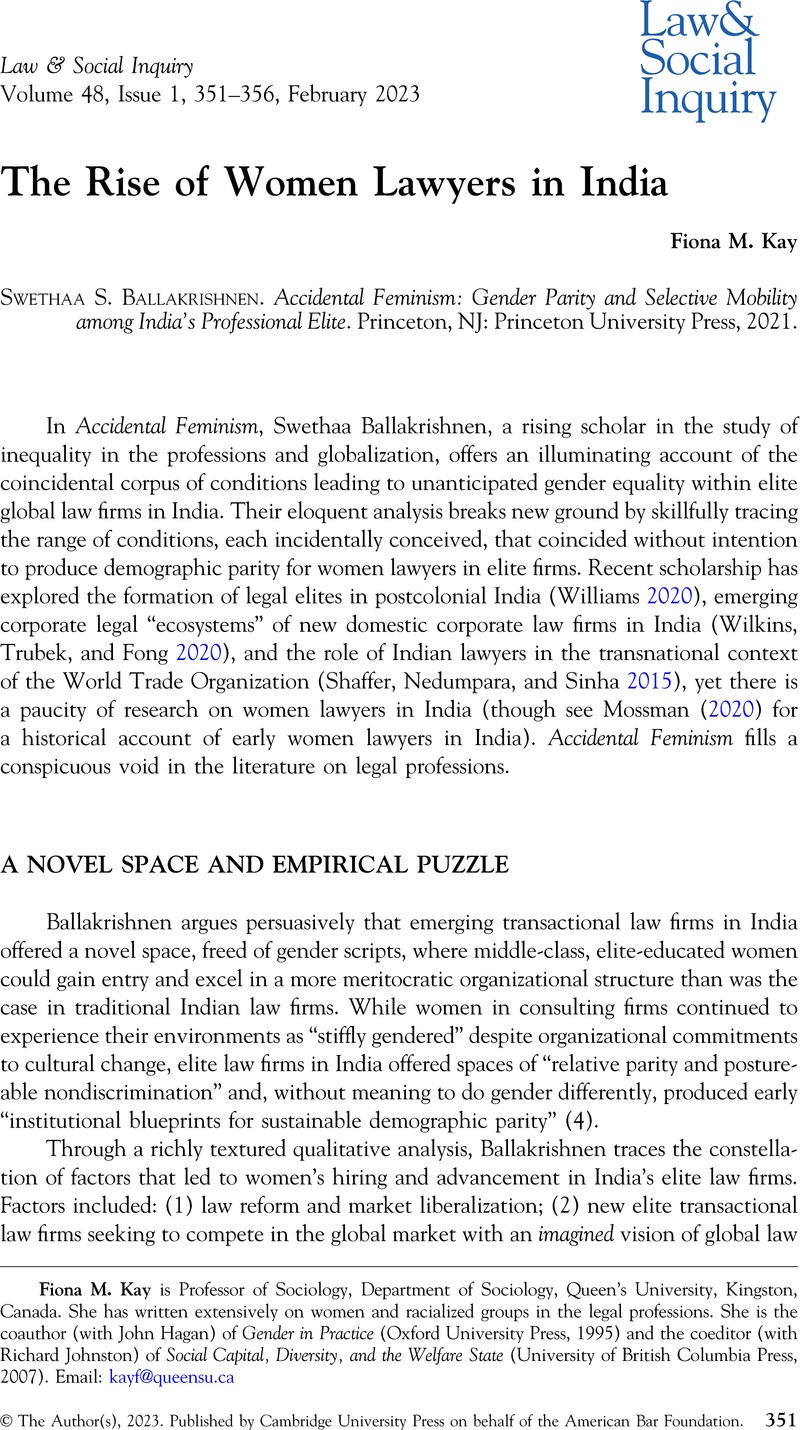No CrossRef data available.
Article contents
The Rise of Women Lawyers in India
Review products
Swethaa S. Ballakrishnen. Accidental Feminism: Gender Parity and Selective Mobility among India’s Professional Elite. Princeton, NJ: Princeton University Press, 2021.
Published online by Cambridge University Press: 03 January 2023
Abstract
An abstract is not available for this content so a preview has been provided. Please use the Get access link above for information on how to access this content.

- Type
- International Book Essays
- Information
- Copyright
- © The Author(s), 2023. Published by Cambridge University Press on behalf of the American Bar Foundation
Footnotes
She has written extensively on women and racialized groups in the legal professions. She is the coauthor (with John Hagan) of Gender in Practice (Oxford University Press, 1995) and the coeditor (with Richard Johnston) of Social Capital, Diversity, and the Welfare State (University of British Columbia Press, 2007).
References
REFERENCES
Choroszewicz, Marta, and Kay, Fiona. “Understanding Gender Inequality in the Legal Profession.” Lawyers in the 21st Century: Comparing Legal Professions Thirty Years after Lawyers in Society, vol. 2, edited by Abel, Richard, Sommerlad, Hilary, Hammerslev, Ole, and Schultz, Ulrike, 127–49. Oxford, UK: Hart Publishing, 2022.Google Scholar
Correll, Shelley J. “Reducing Gender Biases in Modern Workplaces: A Small Wins Approach to Organizational Change.” Gender & Society 31, no. 6 (2017): 725–50.CrossRefGoogle Scholar
DiMaggio, Paul J., and Powell, Walter W.. “The Iron Cage Revisited: Institutional Isomorphism and Collective Rationality in Organizational Fields.” American Sociological Review 48, no. 2 (1983): 147–60.CrossRefGoogle Scholar
Halliday, Terence C., and Carruthers, Bruce G.. “The Recursivity of Law: Global Norm Making and National Lawmaking in the Globalization of Corporate Insolvency Regimes.” American Journal of Sociology 112, no. 4 (2007): 1135–1202.CrossRefGoogle Scholar
Mica, Adriana. Sociology as Analysis of the Unintended: From the Problem of Ignorance to the Discovery of the Possible. New York: Routledge, 2018.Google Scholar
Michelson, Ethan. “Women in the Legal Profession, 1970-2010: A Study of the Global Supply of Lawyers.” Indiana Journal of Global Legal Studies 20, no. 2 (2013): 1071–98.CrossRefGoogle Scholar
Mossman, Mary Jane. “Cornelia Sorabji (1866-2954): A Pioneer Woman Lawyer in Britain and India.” Women’s History Review 29, no. 4 (2020): 737–47.CrossRefGoogle Scholar
Ridgeway, Cecilia L. Framed by Gender: How Gender Inequality Persists in the Modern World. Oxford: Oxford University Press, 2011.CrossRefGoogle Scholar
Ridgeway, Cecilia L. Status: Why Is It Everywhere? Why Does It Matter? New York: The Russell Sage Foundation, 2019.CrossRefGoogle Scholar
Shaffer, Gregory, Nedumpara, James, and Sinha, Aseema. “State Transformation and the Role of Lawyers: The WTO, India, and Transnational Legal Ordering.” Law & Society Review 49, no. 3 (2015): 595–629.CrossRefGoogle Scholar
Wilkins, David B., Trubek, David M., and Fong, Bryon. “Globalization, Lawyers, and Emerging Economies: The Rise, Transformation, and Significance of the New Corporate Legal Ecosystem in India, Brazil, and China.” Harvard International Law Journal 61, no. 2 (2020): 281–355.Google Scholar
Williams, Alexander. “Imagining the Post-colonial Lawyer: Legal Elites and the Indian Nation-State, 1947-1967.” Asian Journal of Comparative Law 15, no. 1 (2020): 156–86.CrossRefGoogle Scholar


